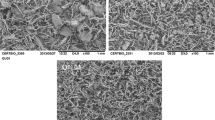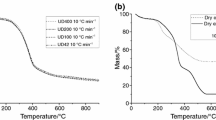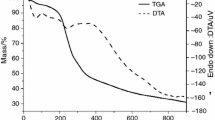Abstract
Poincianella pyramidalis (Tul.) L.P. Queiroz, known as “catingueira,” is a typical species of Caatinga and used in Brazilian folk medicine as anti-inflammatory, antipyretic, diuretic and expectorant. Pharmacological analyses confirmed his activity as anti-inflammatory, antimicrobial and in gastrointestinal disorders. This paper aimed to perform a thermoanalytical characterization of the herbal drugs obtained from P. pyramidalis leaves in different particle sizes. The leaves were dried, pulverized and separated into different granulometric ranges: 50–100, 100–200, 200–400 and <400 mesh. The samples were characterized by thermogravimetry (TG) at different atmospheres and heating rates, determination of the kinetic degradation parameters by Ozawa model, differential thermal analysis (DTA), pyrolysis coupled to gas chromatography interfaced with mass spectrometry (Pyr-GC/MS) and multivariate analysis. TG curves of the samples showed the presence of six thermal decomposition events, with greater mass loss (25.91–35.66%) in the range of 247–398 °C. The thermal degradation proved to be a reaction of zero order, with a decrease in enthalpy and frequency factor with decreasing the granulometric range. DTA curves showed three exothermic events, with peaks around 350, 460 and 490 °C, with variation in enthalpy values. With the Pyr-GC/MS were evidenced different profiles according to the temperature. Principal component analysis of pyrolysis data from samples at different temperatures was able to represent the total variability within the first two principal components, revealing differences between the granulometric ranges. The analytical and statistical techniques used were able to trace characteristic profiles of the herbal drugs, elucidating the differences in each granulometric range.










Similar content being viewed by others
Abbreviations
- TG:
-
Thermogravimetry
- DTA:
-
Differential thermal analysis
- Pyr-GC/MS:
-
Pyrolysis coupled to gas chromatography interfaced with mass spectrometry
- PCA:
-
Principal component analysis
- HCA:
-
Hierarchical cluster analysis
- ACAM:
-
Manuel de Arruda Câmara herbarium
- β:
-
Heating ratio
- n :
-
Reaction order
- E a :
-
Activation energy
- A :
-
Frequency factor
- EI:
-
Electron impact
- m/z :
-
Mass-to-charge ratio
- T onset :
-
Initial temperature
- T endset :
-
Final temperature
References
Souza-Moreira TM, Salgado HRN, Pietro RCLR. O Brasil no contexto de controle de qualidade de plantas medicinais. Rev Bras Farmacogn. 2010;20:435–40.
Svetaz L, Zuljan F, Derita M, Petenatti E, Tamayo G, Cáceres A, et al. Value of the ethnomedical information for the discovery of plants with antifungal properties. A survey among seven Latin American countries. J Ethnopharmacol. 2010;127:137–58.
Oh SJ, Cho JH, Son CG. Systematic review of the incidence of herbal drug-induced liver injury in Korea. J Ethnopharmacol. 2015;159:253–6.
Santana DG, Santos CA, Santos ADC, Nogueira PCL, Thomazzi SM, Estevam CS, et al. Beneficial effects of the ethanol extract of Caesalpinia pyramidalis on the inflammatory response and abdominal hyperalgesia in rats with acute pancreatitis. J Ethnopharmacol. 2012;142:445–55.
Saraiva AM, Saraiva CL, Gonçalves AM, Soares RR, Mendes FO, Cordeiro RP, et al. Antimicrobial activity and bioautographic study of antistaphylococcal components from Caesalpinia pyramidalis Tull. Braz J Pharm Sci. 2012;48:147–54.
Ribeiro ARS, Diniz PBF, Estevam CS, Pinheiro MS, Albuquerque-Júnior RLC, Thomazzi SM. Gastroprotective activity of the ethanol extract from the inner bark of Caesalpinia pyramidalis in rats. J Ethnopharmacol. 2013;147:383–8.
Diniz PBF, Ribeiro ARS, Estevam CS, Bani CC, Thomazzi SM. Possible mechanisms of action of Caesalpinia pyramidalis against ethanol-induced gastric damage. J Ethnopharmacol. 2015;168:79–86.
Santos CA, Santos DS, Santana DG, Thomazzi SM. Evaluation of mechanisms involved in the antinociception of the ethanol extract from the inner bark of Caesalpinia pyramidalis in mice. J Ethnopharmacol. 2013;148:205–9.
Silva CHTP, Peixoto Sobrinho TJS, Saraiva AM, Pisciottano MNC, Amorim ELC. Phytochemical profile and antibacterial activity of bark and leaves of Caesalpinia pyramidalis Tul. and Sapium glandulosum (L.) Morong. J Med Plants Res. 2012;6:4766–71.
Kroes BH. The legal framework governing the quality of (traditional) herbal medicinal products in the European Union. J Ethnopharmacol. 2014;158:449–53.
Correia LP, Procópio JVV, Santana CP, Pinto MF, Moura EA, Santos AFO, et al. Herbal medicine physical quality evaluation by thermal analysis using adapted Ozawa method. J Therm Anal Calorim. 2015;122:207–14.
Correia PRM, Ferreira MMC. Reconhecimento de padrões por métodos não supervisionados: explorando procedimentos quimiométricos para tratamento de dados analíticos. Quim Nova. 2007;30:481–7.
Pan L, Dai F, Li G, Liu S. A TGA/DTA-MS investigation to the influence of process conditions on the pyrolysis of Jimsar oil shale. Energy. 2015;86:749–57.
Oliveira EJ, Alvarez EDA, Lima NGPB, Macedo RO. Usefulness of pyrolysis coupled to gas chromatography/mass spectrometry for evaluating the reproducibility of commercial samples of Cymbopogon citratus Stapf., Poaceae. Rev Bras Farmacogn. 2010;20:93–9.
Prata VM, Emídio ES, Doreá HS. Aplicação de métodos quimiométricos na caracterização de charutos utilizando a extração por dispersão da matriz em fase sólida e análise por cromatografia gasosa acoplada à espectrometria de massas. Quim Nova. 2011;34:53–8.
Author information
Authors and Affiliations
Corresponding author
Rights and permissions
About this article
Cite this article
Guimarães, G.P., Santos, R.L., Brandão, D.O. et al. Thermoanalytical characterization of herbal drugs from Poincianella pyramidalis in different particle sizes. J Therm Anal Calorim 131, 661–670 (2018). https://doi.org/10.1007/s10973-016-6076-4
Received:
Accepted:
Published:
Issue Date:
DOI: https://doi.org/10.1007/s10973-016-6076-4




